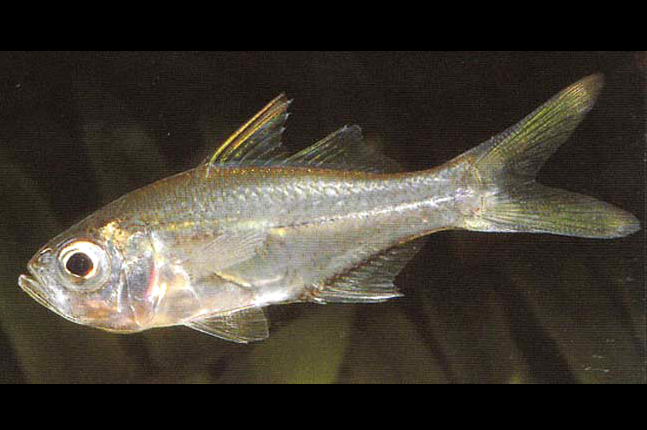Flagtail Glassfish, Ambassis miops Günther 1872

Flagtail Glassfish, Ambassis miops. Source: Gerald R. Allen. License: All rights reserved
Flagtail Glassfish, Ambassis miops Günther 1872
More Info
|
Distribution |
In Australia known only from coastal areas of the Cape York Peninsula Queensland, from the Starcke River (14º49´S) to Cairns (16º55´S). Also known from Indonesia, New Guinea, New Caledonia and Rarotoga. Tropical, aggregating in clear, flowing freshwater creeks, mangroves and estuaries within 20 km of the sea. |
|
Features |
D VIII, 9-10; A III, 9-10; P 13-14; Body ovate, compressed, relatively slender; greatest body depth 33.4-38.6 % SL; head length 35.5 to 38.6; snout length 6.7 to 9.1; eye relatively large, diameter 12.9 to 15.0; mouth large, oblique; single supraorbital spine; 2 transverse scale rows on cheek; lateral line usually continuous from upper edge of gill opening to caudal fin base; nasal spine present; Scales cycloid, large; horizontal scale rows 9-10; vertical scale rows 28-30; lateral line scales 28-30. Dorsal fin deeply notched, origin forward of ventral fins; first dorsal spine small, projecting forward; anal fin opposite soft rays of dorsal; height of first dorsal fin 24.6 to 28.3; third dorsal spine slightly longer than second dorsal spine; third anal spine longer than second anal spine; anal and dorsal fins with scaly basal sheath; pectoral fins of moderate size; ventral fins large; caudal fin strongly forked, lobes rounded. |
|
Size |
To 8 cm SL. |
|
Colour |
Semi-transparent with a silvery/bronze midlateral stripe and dark scale margins that form a faint reticulated pattern dorsally and laterally. Fins mainly clear but sometimes with yellow/bronze on caudal and anterior part of dorsal fin. |
|
Feeding |
Feed mainly on aquatic insects but also on smaller fishes, crustaceans and some algae from woody debris. |
|
Biology |
Little is known of the reproductive biology of this species but because of its broad distribution it is thought to have a marine larval phase. |
|
Conservation |
Not listed on the IUCN Red List of Threatened Species. Not listed under the Australian EPBC Act. |
|
Remarks |
This species is locally abundant but found only from a few sites in Australia. |
|
Etymology |
The specific name is from the Greek meion (= less, little) and opsis (= eye), in reference to the small spine above the eye. |
|
Species Citation |
Ambassis miops Günther, A. (1872). Report on several collections of fishes recently obtained for the British Museum. Proc. Zool. Soc. Lond. 1871(3): 652–675 pls 53–70 [655]. Rarotonga, Cook Ils. |
|
Author |
Thompson, V.J. & Bray, D.J. 2021 |
Flagtail Glassfish, Ambassis miops Günther 1872
References
Allen, G.R. (1989). Freshwater Fishes of Australia. Neptune, New Jersey : T.F.H. Publications pp. 1–240
Allen, G.R., Midgley, S.H. & Allen, M. (2002). Field guide to the freshwater fishes of Australia. Perth : Western Australian Museum 394 pp.
Pusey, B.J., Arthington, A.H. & Read, M.G. 1995. Species richness and spatial variation in fish assemblage structure in two rivers of the wet tropics of northern Queensland, Australia. Environmental Biology of Fish 42(2): 181-199.
Larson, H. 2012. Ambassis miops. The IUCN Red List of Threatened Species. Version 2015.1.
Pusey B., Kennard M. & Arthington A. (2004) Freshwater Fishes of North-Eastern Australia. CSIRO Publishing, Collingwood, Victoria.
Pusey, B.J., M.G. Read & A.H. Arthington. 1995. The feeding ecology of freshwater fishes in two rivers of the Australian wet tropics. Environmental Biology of Fish 43(1): 85-103.

